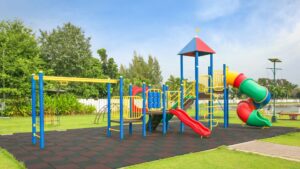Introduction to Sensory Integration for Children
Sensory integration activities are essential for young children as they support physical, cognitive, and emotional development. These games help kids improve coordination, balance, and motor skills, all while having fun! Whether you’re a parent or teacher, these 70 activities are designed to be simple, effective, and enjoyable for children aged 1-6.
1. Ball Toss Game (1-2 Years Old)
Purpose: Social skills / arm coordination
Instructions: Sit face-to-face with your child and pass the ball back and forth.
Difficulty Levels:
- A: Start by placing the ball in the child’s hand.
- B: Hold the ball out for the child to reach.
- C: When the child hands the ball back, say “Thank you” to encourage reciprocity.
Support: If the child is not yet initiating the game, gently guide their hands and actions.
2. Catch and Roll the Ball (1-2 Years Old)
Purpose: Hand-eye coordination / arm strength
Instructions: Sit across from your child and roll the ball back and forth. Encourage them to catch and return it.
Difficulty Levels:
- A: Keep the ball within easy reach.
- B: Gradually increase the distance and encourage them to use both hands to catch.
Support: Provide guidance as needed, helping them learn to independently catch and roll the ball.
3. Climbing Stairs (1-2 Years Old)
Purpose: Balance, coordination, and walking independence
Instructions: Encourage your child to step with one foot, then bring the other foot to the same step.
Difficulty Levels:
- A: Hold the child’s hand for support.
- B: Let them try on their own once they’re comfortable.
Support: Use verbal cues and physical guidance to assist, especially in the beginning.
4. Touching Toes (1-2 Years Old)
Purpose: Flexibility and physical strength
Instructions: Place stickers on the child’s toes and encourage them to bend down and peel off the stickers.
Difficulty Levels:
- A: Place the feet on a low surface to make it easier.
- B: Challenge them to touch their toes and remove more stickers.
Support: Gently guide their legs to help with bending.
5. Walking Up/Down a Small Slope (1-2 Years Old)
Purpose: Balance and control of body weight
Instructions: Encourage your child to walk up and down a slight slope.
Difficulty Levels:
- A: Hold their hand for support.
- B: Let them walk independently when ready.
Support: Assist them by guiding their hands or providing support on steep slopes.
6. Walking Backwards (1-2 Years Old)
Purpose: Spatial awareness and coordination
Instructions: Teach your child to walk backwards along a straight line.
Difficulty Levels:
- A: Let them walk freely on a smooth surface.
- B: Guide them along a line or path.
Support: Offer physical assistance, gently guiding their movements.
7. Back Scratching Game (1-2 Years Old)
Purpose: Skin sensory stimulation
Instructions: While giving your child a bath, gently rub their back with a sponge or towel.
Support: Adjust the pressure based on their comfort level.
8. Tickle Time (1-2 Years Old)
Purpose: Skin sensory stimulation
Instructions: Gently tickle your child in areas like the neck, underarms, and feet.
Support: Start with light strokes if they are sensitive, gradually increasing as they become accustomed to it.
9. Brush Desensitization (1-2 Years Old)
Purpose: Tactile sensory development
Instructions: Use a soft brush to gently brush the child’s hand, arm, and eventually feet.
Support: Start with less sensitive areas and move to more sensitive parts of the body.
10. Sunshine Tunnel (1-2 Years Old)
Purpose: Vestibular system regulation
Instructions: Encourage your child to crawl through a play tunnel.
Difficulty Levels:
- A: Let them explore the tunnel and get used to it.
- B: Place a favorite toy or snack inside to motivate them.
Support: Encourage and guide them through the tunnel without forcing them.
11. Push the “Fun Ball” to a Target (2-3 Years Old)
Purpose: Social skills and hand-eye coordination
Instructions: Have the child push a ball towards a target 1 meter away.
Difficulty Levels:
- A: Start with a close distance and simple instructions.
- B: Increase the distance and complexity as they improve.
Support: Provide gentle guidance and verbal prompts.
12. Push and Catch the Ball Against a Wall (2-3 Years Old)
Purpose: Arm coordination and hand-eye coordination
Instructions: Encourage your child to push a ball towards a wall and catch the rebound.
Difficulty Levels:
- A: Start with a short distance.
- B: Gradually increase the distance and encourage them to catch the ball on the rebound.
Support: Use physical assistance as needed.
13. Push Objects Forward (2-3 Years Old)
Purpose: Arm strength and coordination
Instructions: Have your child push a toy (like a squeaky duck) forward for 2-3 meters.
Difficulty Levels:
- A: Start with simple objects and short distances.
- B: Increase the complexity by adding more obstacles.
Support: Guide them with prompts and help them move in the right direction.
14. Pull an Object (2-3 Years Old)
Purpose: Coordination and motor control
Instructions: Have your child pull a toy car using a string.
Difficulty Levels:
- A: Start with a short distance.
- B: Gradually increase the distance and challenge them with different obstacles.
Support: Offer gentle assistance and guidance to help them pull the object effectively.
15. Toss a Medium Ball into a Basket (2-3 Years Old)
Purpose: Hand-eye coordination
Instructions: Have your child toss a medium-sized ball into a basket from a short distance.
Difficulty Levels:
- A: Start with a close range.
- B: Increase the distance and complexity by asking them to hit the target more accurately.
Support: Help them with positioning and provide encouragement.
16. Kick a Ball 1 Meter Forward (2-3 Years Old)
Purpose: Leg coordination and hand-eye coordination
Instructions: Place a soft ball in front of your child and encourage them to kick it forward.
Difficulty Levels:
- A: Start with a short distance.
- B: Gradually increase the distance and add more complexity.
Support: Provide guidance to help them aim and kick effectively.
17. Wall Rolling Game (5-6 Years Old)
Purpose: Tactile stimulation and motor planning
Instructions: Have your child roll against a wall, simulating wallpapering motions.
Difficulty Levels:
- A: Start with small, controlled movements.
- B: Allow them to move across the wall from one end to the other.
Support: Guide them to avoid hitting the wall too hard, ensuring they maintain safety.
18. Hula Hoop Leg Crossing (2-3 Years Old)
Purpose: Body coordination and balance
Instructions: Show your child how to bend down and cross each leg through a hula hoop.
Difficulty Levels:
- A: Start with the hoop low, helping them grip it.
- B: Gradually increase the height and complexity of the task.
Support: Offer physical assistance and guide their movements.
19. Sitting on a Pushchair (2-3 Years Old)
Purpose: Leg control and coordination
Instructions: Place your child in a pushchair and guide them as they keep their feet on the footrests while moving.
Support: Assist with controlling the movement and balance during the activity.
20. Walking in a Zigzag Pattern (2-3 Years Old)
Purpose: Spatial awareness and balance
Instructions: Mark a zigzag line on the floor and guide your child as they walk along it.
Difficulty Levels:
- A: Walk half of the pattern.
- B: Complete the entire zigzag path.
Support: Offer guidance, either by holding their hand or verbally prompting.
Sensory Games for Growth and Fun
These sensory integration activities are designed to enhance motor skills, balance, coordination, and social development. Whether you’re a teacher or a parent, incorporating these fun games into your child’s routine will help them build essential skills in an enjoyable and engaging way.
Download our complete sensory integration guide for more activities and tips to support your child’s development.





